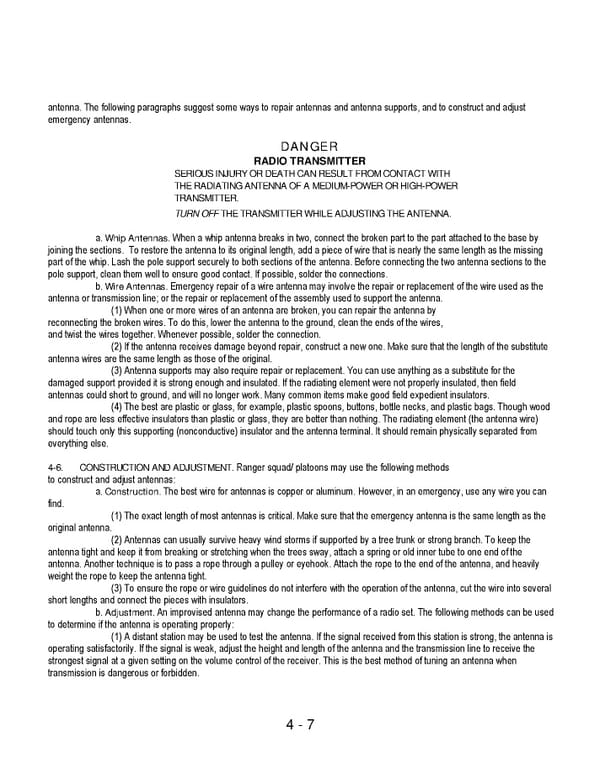4 - 7 antenna. The following paragraphs suggest some ways to repair antennas and antenna supports, and to construct and adjust emergency antennas. DANGER RADIO TRANSMITTER SERIOUS INJURY OR DEATH CAN RESULT FROM CONTACT WITH THE RADIATING ANTENNA OF A MEDIUM-POWER OR HIGH-POWER TRANSMITTER. TURN OFF THE TRANSMITTER WHILE ADJUSTING THE ANTENNA. a. Whip Antennas. When a whip antenna breaks in two, connect the broken part to the part attached to the base by joining the sections. To restore the antenna to its original length, add a piece of wire that is nearly the same length as the missing part of the whip. Lash the pole support securely to both sections of the antenna. Before connecting the two antenna sections to the pole support, clean them well to ensure good contact. If possible, solder the connections. b. Wire Antennas. Emergency repair of a wire antenna may involve the repair or replacement of the wire used as the antenna or transmission line; or the repair or replacement of the assembly used to support the antenna. (1) When one or more wires of an antenna are broken, you can repair the antenna by reconnecting the broken wires. To do this, lower the antenna to the ground, clean the ends of the wires, and twist the wires together. Whenever possible, solder the connection. (2) If the antenna receives damage beyond repair, construct a new one. Make sure that the length of the substitute antenna wires are the same length as those of the original. (3) Antenna supports may also require repair or replacement. You can use anything as a substitute for the damaged support provided it is strong enough and insulated. If the radiating element were not properly insulated, then field antennas could short to ground, and will no longer work. Many common items make good field expedient insulators. (4) The best are plastic or glass, for example, plastic spoons, buttons, bottle necks, and plastic bags. Though wood and rope are less effective insulators than plastic or glass, they are better than nothing. The radiating element (the antenna wire) should touch only this supporting (nonconductive) insulator and the antenna terminal. It should remain physically separated from everything else. 4-6. CONSTRUCTION AND ADJUSTMENT. Ranger squad/ platoons may use the following methods to construct and adjust antennas: a. Construction. The best wire for antennas is copper or aluminum. However, in an emergency, use any wire you can find. (1) The exact length of most antennas is critical. Make sure that the emergency antenna is the same length as the original antenna. (2) Antennas can usually survive heavy wind storms if supported by a tree trunk or strong branch. To keep the antenna tight and keep it from breaking or stretching when the trees sway, attach a spring or old inner tube to one end of the antenna. Another technique is to pass a rope through a pulley or eyehook. Attach the rope to the end of the antenna, and heavily weight the rope to keep the antenna tight. (3) To ensure the rope or wire guidelines do not interfere with the operation of the antenna, cut the wire into several short lengths and connect the pieces with insulators. b. Adjustment. An improvised antenna may change the performance of a radio set. The following methods can be used to determine if the antenna is operating properly: (1) A distant station may be used to test the antenna. If the signal received from this station is strong, the antenna is operating satisfactorily. If the signal is weak, adjust the height and length of the antenna and the transmission line to receive the strongest signal at a given setting on the volume control of the receiver. This is the best method of tuning an antenna when transmission is dangerous or forbidden.
 Ranger Handbook Page 74 Page 76
Ranger Handbook Page 74 Page 76